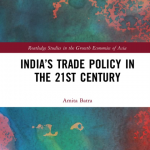Global trade in the last two decades touched a record $28.5 trillion from less than $10 trillion and, remarkably, the share of developing countries has grown substantially to 40 per cent. India’s share in global trade increased from 0.5% to 1.6%, while that of China’s doubled from 6.7% to 12.3 per cent. The share of East Asian and ASEAN countries, especially Vietnam, has also dramatically improved during this period. Economist Amita Batra explains these shifts in global trade in her book India’s Trade Policy in the 21st Century and underlines how the conscious choices of countries to participate in the Global Value Chains (GVCs) led to the enhancement of their share in global trade.
Batra’s extensive research on GVCs provides rare insights into a highly complex web of backward and forward integration in manufacturing that created regional ‘factories’ of production in specific sectors in the U.S., Japan and Germany. In recent times, the aggressive participation of China and Vietnam in GVC integration pivoted the value chain hubs away from the traditional centers. The author attributes India’s peripheral presence in GVC to its trade policy shortcomings that fails to see the growing relevance of GVC integration in trade and its spillover benefits in terms of foreign direct investment, technology transfers, standards, etc.
The author, who teaches economics at the School of International Studies, Jawaharlal Nehru University, New Delhi, is concerned about high tariffs for a growing economy like India, and the potential damage they cause to domestic industry. She supposes that the drop in India’s average Most Favored Nation tariffs in the 1990s, as part of its trade policy liberalization, should have been backed by further reform when viewed in a comparative context of the world average tariffs having fallen below, either unilaterally or through the preferential route. India’s ability to gain market access in competitive regions that trade at much lower thresholds remains challenging.
For the same reason, Batra cautions against the temptation to build entire supply chains domestically through import substitution with mandatory local content requirements under the Product Linked Incentive (PLI) scheme. This, she says, makes manufacturing inefficient, disincentivizes foreign investment and limits technology transfers. Her findings validate the risks of Import substitution resulting in low value- added exports, as in the case of mobile handsets. Similarly, the highly protected Indian automobile sector has not graduated beyond auto parts, components and the small car segment. India’s global share in textiles too has remained stagnant at 5% and failed to move into technical textiles where world preferences lie.
India’s motivation for entering into Free Trade Agreements (FTA), the author observes, is shaped by geopolitics and strategic considerations rather than by economic and trade logic. The FTAs that India concluded with various countries especially ASEAN, Japan, Korea and, more recently with Australia and the UAE are shallow, with obsolete rules of origin and cumbersome entry barriers. India’s half-hearted approach to FTAs is reflected in its low preference utilization of under 3% compared with developed countries’ utilization of 70-80 per cent. Indian negotiators’ fears of having to eliminate tariffs on ‘substantially all trade’ under FTAs poses a perpetual dilemma when faced with a partner country that has eliminated tariffs substantially on all it products.
India’s trade policy must comprehend the ‘WTO plus’ provisions in the newer FTAs, which are beyond tariff-based market access, to incorporate easier ‘behind the border’ regulatory policies such as trade facilitation, rules of origin, intellectual property, investment protection , e-commerce, competition policy, data, labour, environment etc. In all these areas, domestic reform is urgently needed. Batra says services, India’s strength, should be an integral part of a trade deal, rather than negotiating it on parallel tracks, given that trade-investment-services linkages are inherent to GVCs. With services increasingly embedded in manufacturing, India must not view it purely from the narrow Mode 4 angle. FTAs are designed to facilitate GVC integration with long term gains, and trade deficit is not necessarily a worrisome thing.
Batra recommends strategizing India’s economic partnership with the geographically proximate GVC hub in East and Southeast Asia to attain deeper integration with ‘Factory Asia.’ For the same reason, she makes a strong case for India joining the Regional Comprehensive Economic Partnership. Unless this takes place she says, India’s large market is unlikely to be a preferred option for the ‘China plus one’ strategy for advanced economies and multinationals. India’s discretionary tariff policy has elements of uncertainty which might force investors to rethink options and shift to more predictable countries like Vietnam, Thailand, Bangladesh etc. Plus, developed countries can restore production facilities at home by incorporating artificial intelligence, robotics, 3D, etc.
Batra’s advocacy for India’s deeper GVC integration hinges on a long term visionary approach for promoting economic growth with jobs, an approach that assumes greater urgency in the post pandemic era. The economic boom that India experienced after the 1991 economic reforms, has shown that ‘a rising tide lifts all boats’. It’s time India’s trade policy is reset to position the rising India in the 21st century.
Batra, Amita. India’s Trade Policy in the 21st Century, Routledge (London), 2022.
Dammu Ravi is Secretary (Economic Relations), Ministry of External Affairs.
This book review was exclusively written for Gateway House: Indian Council on Global Relations. You can read more exclusive content here.
For permission to republish, please contact outreach@gatewayhouse.in
©Copyright 2022 Gateway House: Indian Council on Global Relations. All rights reserved. Any unauthorised copying or reproduction is strictly prohibited.


